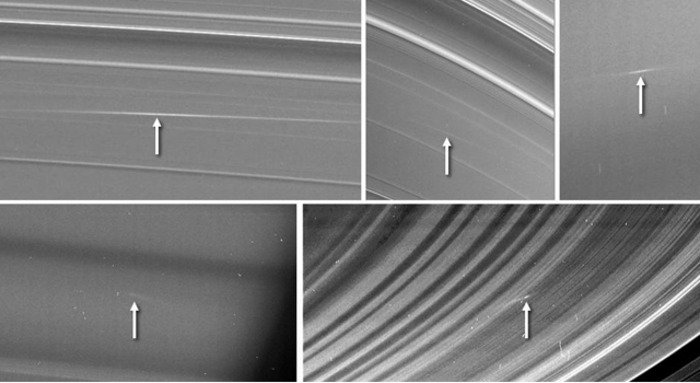Five images of Saturn's rings, taken by NASA's Cassini spacecraft between 2009 and 2012, show clouds of material ejected from impacts of small objects into the rings. Credit: NASA/JPL-Caltech/Space Science Institute/Cornell
PASADENA, Calif., April 26 (UPI) -- NASA says its Cassini spacecraft orbiting Saturn has provided evidence of small meteoroids breaking into streams of rubble and crashing into Saturn's rings.
Images captured by the spacecraft make Saturn's rings the only location besides Earth, the moon and Jupiter where scientists have been able to observe impacts as they occur, NASA's Jet Propulsion Laboratory in Pasadena, Calif., reported Friday.
The meteoroids at Saturn are small, ranging from about a half inch to several yards in size, and it has taken scientists years to distinguish tracks left by nine meteoroids in 2005, 2009 and 2012, JPL said.
"These new results imply the current-day impact rates for small particles at Saturn are about the same as those at Earth -- two very different neighborhoods in our solar system -- and this is exciting to see," Linda Spilker, Cassini project scientist at JPL, said. "It took Saturn's rings acting like a giant meteoroid detector -- 100 times the surface area of the Earth -- and Cassini's long-term tour of the Saturn system to address this question."
Under certain conditions when the sun shines on the rings at a shallow angle, the clouds of meteor debris look bright against the darkened rings in pictures from Cassini's imaging science subsystem, researchers said.
"We knew these little impacts were constantly occurring, but we didn't know how big or how frequent they might be, and we didn't necessarily expect them to take the form of spectacular shearing clouds," Matt Tiscareno, a Cassini participating scientist at Cornell University, said. "The sunlight shining edge-on to the rings at the Saturnian equinox acted like an anti-cloaking device, so these usually invisible features became plain to see."















